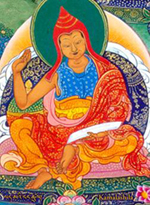The Council of Lhasa did not take place in Lhasa, but rather at the Samye monastery, which is located 3-1/2 hours away from Lhasa by bus these days. Samye is said to be the oldest monastery in Tibet, built in the middle of the 8th century at the request of King Trisong Detsen (one of the three Dharma Kings of Tibet) with the help of Padmasambhava, who brought to the local spirits to heel, and the scholar-monk Shantarakshita. The grounds at Samye are laid out in a mandala pattern and the main building is said to be based on Odantapuri, one of the great Buddhist universities of India, now destroyed (Odantapuri’s high walls caused it to be mistaken for a fortress by the general Khalji, who conquered Bihar and Bengal at the end of the 12th century. Though if it had low walls, he might have knocked them down too.)
The story goes that King Trisong Detsen began to suspect that the visiting Chinese teacher, Hoshang Mahayana, or Heshang Mo-he-yan, was not teaching the true dharma. In what would become a great Tibetan tradition, a debate—or series of debates, one of which, presumably the deciding one, is known as the Council of Lhasa—was arranged between Hoshang and the Indian pandit, or scholar, Kamalashila. The debates went on for several years. Although it’s difficult to say precisely what positions the two were espousing, Hoshang is said to have argued for a strain of Chan/Zen from the so-called Northern school. Jeffrey Broughton writes (via Wikipedia):
Mo-ho-yen’s teaching in Tibet as the famed proponent of the all-at-once gate can be summarized as “gazing-at-mind” ([Chinese:] k’an-hsin… = [Tibetan:] sems la bltas) and “no examining” ([Chinese:] pu-kuan… = [Tibetan:] myi rtog pa) or “no-thought no-examining” ([Chinese:] pu-ssu pu-kuan… = [Tibetan:] myi bsam myi rtog). “Gazing-at-mind” is an original Northern (or East Mountain Dharma Gate) teaching. As will become clear, Poa-t’ang and the Northern Ch’an dovetail in the Tibetan sources. Mo-ho-yen’s teaching seems typical of late Northern Ch’an. It should be noted that Mo-ho-yen arrived on the central Tibetan scene somewhat late in comparison to the Ch’an transmissions from Szechwan.
Kamalashila is usually said to be an adherent of the Madhyamaka school:
The Indian pandits, represented mainly by Śāntarakṣita, Kamalaśīla, and his disciple Ye-śes-dbang-po, form a known group. These scholars were all defenders of the Madhyamaka school, which is based upon Nāgārjuna’s teachings. First of all, however, they taught the ten rules of behaviour of the Buddhist ethics (śīla) and a summary of the teachings according to the canonic Sūtras of the Mahāyāna, as well as the virtuous works of the six pāramitās. These exercises are supposed to lead, in a long seemingly endless way, to the gradual ascent to the acquisition of higher intellectual abilities finally culminating in Buddhahood. This trend was intensified after the debate of bSam-yas had taken place in the years 792 to 794; the exact outcome of this debate is still debatable.
 Most accounts indicate that Kamalashila came out on top and that Hoshang was banished from Tibet, and from this we have Tibetan Buddhism—which is itself a multiplicity and has had another 1200 years to develop. Some Chinese sources, understandably, give the victory to Hoshang.
Most accounts indicate that Kamalashila came out on top and that Hoshang was banished from Tibet, and from this we have Tibetan Buddhism—which is itself a multiplicity and has had another 1200 years to develop. Some Chinese sources, understandably, give the victory to Hoshang.
This debate can be thought of as Indian Buddhism vs. Chinese Buddhism, but of course the situation is far more complex than that. By this point in history, Buddhism was well over a thousand years old and Indian, Himalayan, and Chinese Buddhism were influencing each other in all directions.
The Samten Migdron and other texts discovered at Dunhuang (where Hoshang was also a teacher) indicate some historical relationship between Zen and Dzogchen, and between Chinese and Indo-Tibetan tantric Buddhism generally. In our upcoming issue, we’ll be featuring an article about recent discoveries in Gandharan sites (in modern-day Afghanistan, where a very old monastery was just discovered) which reveals even more about the shared roots of the Buhdhist traditions, and makes dubious claims to authenticity and purity even more dubious.